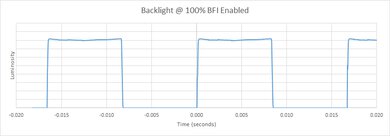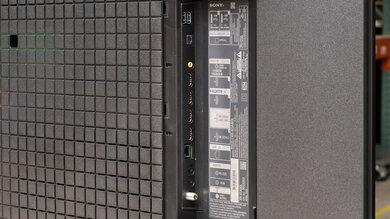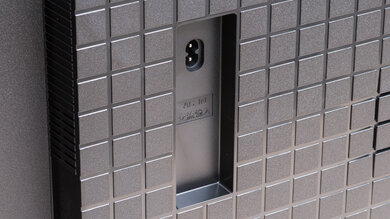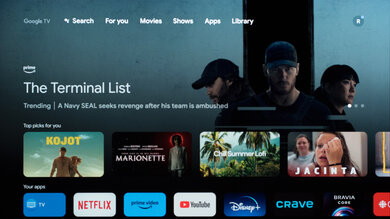The Sony A80L OLED is an entry-level OLED model for 2023, sitting above the Sony A75L OLED. It uses a WOLED panel from LG, and it sits below the Sony A90K OLED and the QD-OLED-equipped Sony A95L OLED. It's a full-featured TV with full HDMI 2.1 bandwidth support on two of its HDMI ports for up to 4k @ 120Hz gaming and both HDMI Forum VRR and G-SYNC variable refresh rate support. The TV has Sony's latest Cognitive Processor XR, which powers the TV's image processing and upscaling capabilities. The A80L uses the popular Google TV as its smart OS platform, and the TV has an internal microphone for hands-free voice control. Other great features are its S-Center speaker input, which can turn the TV into a center speaker channel when a Sony soundbar is connected, and an ATSC 3.0 tuner for up to 4k over-the-air broadcast support. The TV comes in 55, 65, 77, and 83-inch sizes.
Our Verdict
Overall, the Sony A80L is an excellent TV for mixed usage. Its HDR peak brightness is good, so movies pop when watched in a dark room. Its SDR brightness is slightly less impressive, but the TV makes up for it with fantastic reflection handling, so the TV looks great when watching TV shows and sports in a bright room. As with all OLEDs, the TV stands out for gaming, with extremely low input lag and a nearly instantaneous response time. Unfortunately, the TV's HDR brightness takes a dip in Game Mode, so play HDR games in a dark room for the best visual impact. The same great gaming features also make it a great choice to use as a PC monitor, although, as with all OLEDs, there's a risk of burn-in. Overall, it's an amazing TV for every context.
- Perfect black uniformity.
- Near-infinite contrast ratio for deep blacks.
- No issues upscaling lower-resolution content.
- Incredible reflection handling.
- Fantastic viewing angle.
- Decent SDR brightness, but still lower than its competition.
- Has only two HDMI 2.1 ports, one of which is the eARC port.
The Sony A80L is a great TV for watching TV shows. Its SDR brightness is satisfactory but not spectacular, but in turn, its reflection handling is exceptional, so it handles bright rooms well. It has a fantastic viewing angle, so even when watching a TV show with your family all sitting around the TV, everyone watching will see a consistent image. As with most Sony TVs, the A80L has Sony's class-leading processing capabilities, so low-resolution shows on cable look great, as well as low-bitrate streaming content from your favorite streaming services.
- No issues upscaling lower-resolution content.
- Incredible reflection handling.
- Fantastic viewing angle.
- Decent SDR brightness, but still lower than its competition.
The Sony A80L is excellent for watching sports. Its SDR brightness is satisfactory, but when combined with the TV's exceptional reflection handling, it makes sports look great even in a bright room. The TV has excellent gray uniformity, so you won't notice weird smudges on a white rink when watching hockey, for example. The TV's viewing angle is fantastic, so the entire gang can sit around the TV to watch the game and still experience a consistent image. Finally, it has a nearly instantaneous response time, so there's almost no blur behind fast-moving objects like a puck or ball.
- No issues upscaling lower-resolution content.
- Incredible reflection handling.
- Fantastic viewing angle.
- Superbly low response time so fast-moving objects look smooth.
- Decent SDR brightness, but still lower than its competition.
The Sony A80L is a fantastic gaming TV. It has exceptionally low input lag, so your inputs are super responsive. Its contrast and dark details are preserved very well in Game Mode, so you can simultaneously have great image quality and the lowest input lag possible. As with all OLEDs, its response time is almost instantaneous, so games are free of blur or black smearing, and the action looks sharp. It has HDMI 2.1 bandwidth on two of its HDMI ports for up to 4k @ 120Hz gaming and G-SYNC and HDMI Forum VRR variable refresh rate support for nearly tear-free gaming, so it's a fully featured gaming TV.
- No issues upscaling lower-resolution content.
- Superbly low response time so fast-moving objects look smooth.
- VRR support and HDMI 2.1 bandwidth for up to 4k @ 120Hz gaming.
- Very low input lag.
- No FreeSync VRR support.
- Decent SDR brightness, but still lower than its competition.
- Has only two HDMI 2.1 ports, one of which is the eARC port.
The Sony A80L is excellent for watching HDR movies. Its near-infinite contrast ratio gives it perfect blacks, and the TV's good HDR brightness makes for an amazing viewing experience in a dark room. Of course, being a Sony TV, it has amazing processing features; it upscales low-resolution content extremely well, and low-bitrate content, which includes content from well-known streaming services, looks its best on this TV due to its amazing low-quality content smoothing. It's also configured well out of the box, giving you a great viewing experience without spending time or money on calibration. As typical of Sony, it's a standout TV for movies.
- Perfect black uniformity.
- Near-infinite contrast ratio for deep blacks.
- Removes 24p judder from any source.
- Displays a wide range of colors.
- Supports advanced audio and video formats, like DTS and Dolby Vision.
- Stutter due to near-instantaneous response time.
The Sony A80L is an amazing TV for HDR gaming. Its HDR brightness in Game Mode is reasonable; certainly not the greatest, but it does the trick. The TV makes up for it with a suite of excellent gaming features. It has superbly low input lag for super response gaming, and you can have both the lowest input lag and the best image quality simultaneously due to the TV's incredible contrast and dark details when in Game Mode. It has a nearly instantaneous response time, so the latest HDR-enabled titles look sharp and blur-free in even the most heated scenes. Finally, it has HDMI 2.1 bandwidth support on two of its HDMI ports for up to 4k @ 120Hz gaming and support for both G-SYNC and HDMI Forum VRR for nearly tear-free gaming.
- Perfect black uniformity.
- Near-infinite contrast ratio for deep blacks.
- Superbly low response time so fast-moving objects look smooth.
- VRR support and HDMI 2.1 bandwidth for up to 4k @ 120Hz gaming.
- Very low input lag.
- Displays a wide range of colors.
- No FreeSync VRR support.
- Limited HDR peak brightness in Game Mode.
- Has only two HDMI 2.1 ports, one of which is the eARC port.
The Sony A80L is a remarkable TV to use as a PC monitor. Its SDR and HDR peak brightness levels are satisfactory overall but nothing special. However, the TV's incredible reflection handling makes up for it in a big way; it can certainly handle a bright office. Still, the TV is packed with features making it great for PC usage; superbly low input lag for super responsive mouse inputs, remarkably low response time for no annoying trails behind your mouse cursor or when moving windows, and an outstanding viewing angle so the sides of the screen stay consistent even when you're sitting extremely close it. As with all OLEDs, there's a risk of burn-in when exposed to the same static elements for a length of time, like if you leave icons or the taskbar visible on screen, and its non-RGB subpixel layout negatively impacts text clarity.
- Incredible reflection handling.
- Fantastic viewing angle.
- Superbly low response time so fast-moving objects look smooth.
- VRR support and HDMI 2.1 bandwidth for up to 4k @ 120Hz gaming.
- Very low input lag.
- Displays a wide range of colors.
- Limited HDR peak brightness in Game Mode.
- Decent SDR brightness, but still lower than its competition.
- Risk of burn-in.
- Has only two HDMI 2.1 ports, one of which is the eARC port.
Changelog
- Updated Jun 20, 2024: Mentioned the newly-reviewed Sony BRAVIA 8 OLED in the HDR Brightness In Game Mode section of this review.
- Updated Dec 13, 2023: We confirmed that the TV uses version 10 of Google TV and not version 11, as previously stated in the review. The version in the Interface section of the review has been updated with the correct information.
- Updated Nov 24, 2023: We bought and tested the Sony A75L OLED, and added a few comparisons below in the Compared To Other TVs section and the Remote section of the review.
- Updated Nov 22, 2023: After testing the Sony A75L OLED, we noticed that the color volume of this TV was lower than expected. We remeasured the Color Volume and updated the results below, and the numbers are much more in line with our expectations.
Check Price
Differences Between Sizes And Variants
We tested the 65-inch Sony A80L, and the results are also valid for the 55, 77, and 83-inch models. It's also known as the A80CL at Costco, and it's the same TV, but the only difference is that it comes with a backlit remote, a three-year extended warranty, and a two-year subscription to the Bravia Core Streaming Service with 15 movie credits. In Europe, there are both the Sony A80L and the Sony A84L, and both TVs perform like the North American A80L.
| Size | Model | Costco Variant |
|---|---|---|
| 55" | Sony XR-55A80L | Sony XR-55A80CL |
| 65" | Sony XR-65A80L | Sony XR-65A80CL |
| 77" | Sony XR-77A80L | Sony XR-77A80CL |
| 83" | Sony XR-83A80L | Sony XR-83A80CL |
Our unit was manufactured in April 2023; you can see the label here.
Popular TV Comparisons
The Sony A80L is a great TV from Sony. Even though it's one of the lowest-tier OLEDs in their 2023 lineup, it offers a great entry-point into OLED TVs for budget-minded consumers and offers better smart features than the step-down Sony A75L OLED. However, it's also hard to recommend against its competition, partly due to how expensive Sony TVs tend to be. The LG C3 OLED, in particular, tends to be a bit cheaper, has the same advanced audio and video formats, and is quite good at image processing and upscaling. This makes the LG better for everyone except the most demanding movie enthusiasts, who might be better off going with a brighter and better TV, like the Sony A95K OLED.
See our recommendations for the best smart TVs, the best TVs for movies, and the best TVs for PS5.
The Sony BRAVIA 8 OLED is essentially a brighter version of the Sony A80L/A80CL OLED. Both TVs are very similar, but the BRAVIA 8 gets noticeably brighter in SDR, so it overcomes more glare in a bright room. The BRAVIA 8 is also noticeably brighter in HDR when using Game Mode, so you don't have to trade in brightness for the best possible performance. On top of that, the BRAVIA 8 has lower input lag for a more responsive gaming experience. On the other hand, the A80L has better pre-calibration accuracy, and it tracks the PQ EOTF curve closer, so it's the more accurate TV overall.
The LG C4 OLED and Sony A80L/A80CL OLED perform very similarly, although the LG has a small edge in all areas. They both use WOLED panels, so they're about equally as colorful. The LG is, however, noticeably brighter in HDR and SDR than the Sony, so all content pops more on the LG. They're about as good when it comes to processing, but the LG is more accurate in SDR before any calibration. Finally, the LG TV is better for gamers because it has 4k @ 144Hz support on all four HDMI ports, lower input lag, and higher HDR brightness in Game Mode.
The LG G4 OLED is far better than the Sony A80L/A80CL OLED. The LG is brighter in HDR and SDR, and is a far better gaming TV due to its 144Hz support on all four HDMI 2.1 ports; the Sony only supports 4k @ 120Hz on its two HDMI 2.1 ports. The LG is also a bit more accurate out of the box in SDR, although the Sony has better upscaling and much better PQ EOTF Tracking. Ultimately, unless you're a big fan of Sony TVs, the LG is the better product for almost anyone.
The Sony X90L/X90CL and the Sony A80L/A80CL OLED are good for different uses. The Sony A80L has better contrast and perfect black uniformity, delivering inky blacks when viewed in a dark room. The A80L also has a faster response time for less blur behind quick motion, and its wider viewing angle makes it the better choice for watching TV with friends. However, the X90L is the brighter TV that overcomes more glare, so it's better if you regularly watch TV in a bright room.

We buy and test dozens of TVs yearly, taking an objective, data-driven approach to deliver results you can trust. Our testing process is complex, with hundreds of individual tests that take over a week to complete. Most of our tests are done with specially designed test patterns that mimic real content, but we also use the same sources you have at home to ensure our results match the real-world experience. We use two main tools for our testing: a Colorimetry Research CR-100 colorimeter and a CR-250 spectroradiometer.
Test Results

The TV is supported well by its metal feet, with minimal wobbling. You can set the feet at three different positions: a narrow position that is great if you have a small table, a wide position that puts the TV's screen as close as possible to the table for a clean, minimalistic look, and a high position which is high enough to place a soundbar in front of the TV without blocking the screen. You can see the dimensions of the 65-inch TV below (W x D x H to the bottom of the screen):
- Wide position (pictured above): 46.6" x 13" x 1.8"
- Narrow position: 33" x 13" x 1.8"
- Soundbar position: 46.6" x 13" x 3.4"
The back of the TV is made entirely of plastic. There's a cover for cable management, but it doesn't have clips to help route your cables; they just exit straight out of the right side of the TV. While side-facing inputs are easier to reach when the TV is wall-mounted than back inputs are, it's not as easy as if the inputs were closer to the edge. Make sure to remove the cable cover if you wall-mount the TV; otherwise, it makes reaching the inputs from the side much harder.
OLED TVs don't have backlights, but their self-emissive pixels give them the equivalent of a perfect local dimming feature with no zone transitions. We still film the zone transition video on the TV so you can compare it with a TV that does have transitions.
The TV has good HDR peak brightness. Even though it's not bright enough for a truly satisfying HDR experience in a moderately lit room, being an OLED, it looks great in a dark room, where bright highlights pop next to the TV's perfect blacks. The TV's Automatic Brightness Limiter (ABL) is aggressive and significantly dims the TV's brightness when large bright highlights are on the screen.
These measurements are after calibrating the HDR white point with the following settings:
- HDR Picture Mode: Custom
- Brightness: Max
- Contrast: 90
- Color Temperature: Expert 2
- HDR Tone Mapping: Gradation Preferred
- Peak Luminance: High
The TV's HDR brightness in Game Mode is a bit dimmer than in other modes. It's extremely similar in most scenes, but complex scenes with lots of bright highlights are dimmer in Game Mode.
These measurements are after calibrating the HDR white point with the following settings:
- HDR Picture Mode: Game
- Brightness: Max
- HDR Tone Mapping: Gradation Preferred
- Peak Luminance: High
If you need better HDR brightness while using Game Mode, check out the 2024 successor to this TV, the Sony BRAVIA 8 OLED.
The TV has superb PQ EOTF tracking; it follows the target curve almost perfectly until there's a sharp roll-off at its peak brightness, causing a loss of fine details in bright scenes.
The TV's SDR peak brightness is decent. It doesn't get bright enough to fight a ton of glare. Its Automatic Brightness Limiter (ABL) is aggressive, but only when bright highlights take up most of the screen or if the entire image is bright, like when watching certain bright sports, like hockey. Outside those contexts, the TV's SDR peak brightness doesn't vary much, which is good.
These measurements are after calibration with the following settings:
- Picture Mode: Custom
- Brightness: Max
- Contrast: 90
- Gamma: 0
- Black Level: 50
- Black Adjust: Off
- Adv. Contrast Enhancer: Off
- Peak Luminance: High
The TV has an excellent HDR color gamut; colors look vibrant and life-like. It has nearly perfect coverage of the commonly used DCI-P3 color space and good coverage of the wider and increasingly used Rec. 2020 color space. However, the TV's tone mapping is off in Rec. 2020, especially with desaturated colors. Saturated greens and blues also have tone mapping issues in Rec. 2020.
The Sony A80L has great color volume. As with all OLEDs, it displays dark colors well due to its perfect blacks and near-infinite contrast ratio, but the TV's colors don't get very bright in part due to the A80L's low peak brightness but also due to its WOLED panel.
Even without calibrating it, the Sony A80L OLED has good accuracy in SDR. Its gamma is close to the 2.2 target for moderately-lit rooms, although bright scenes are slightly too bright. Its white balance is decent but could be better; its accuracy worsens as it gets closer to pure white, and blues are overrepresented. The TV's color temperature is slightly on the cold side, giving the TV a slightly blue tint.
The TV is very easy to calibrate, and the results after calibration are fantastic, with almost no flaws whatsoever, except perhaps that bright scenes are now just barely too dark for a moderately-lit room.
You can see the full settings used for our calibration here.
The Sony A80L has excellent gray uniformity. As is typical with WOLED panels, there are some noticeable vertical lines, but you can't see them from a reasonable viewing distance and in more complex scenes than just a single color background.
The TV has great HDR gradient handling; the only really noticeable banding is in dark gray gradients.
As is typical of Sony TVs, the Sony A80L has remarkable sharpness processing capabilities. Low-resolution content is upscaled well, and lines are sharp with very little over-sharpening. Fine details in busy scenes are easy to make out, and hardcoded text looks great.
These results are with the following processing settings:
- Sharpness: 55
- Reality Creation: 20
The TV uses an RWBG panel, or WOLED, with four subpixels. While it doesn't affect picture quality, it's still important for users wanting to use the TV as a PC monitor, as Windows ClearType still can't fully compensate for non-RGB subpixel layouts, negatively affecting text clarity. You can read more about it here.
The TV is not quite flicker-free, as there's a very small dip in brightness every 8 ms, corresponding to the TV's refresh rate. You won't notice it, however, and it's not the same as pulse width modulation (PWM) on LED TVs, as it isn't a full-screen on-and-off cycle.
The TV has an optional black frame insertion feature to reduce persistence blur. Unfortunately, it only works with 60 fps content, so you can't use it with 120 fps video games.
The TV has a motion interpolation feature to bring 30 and 60 fps content up to 120 fps. It does a good job with real content, especially in panning shots and slower dialog scenes. However, as is typical of motion interpolation, once the action ramps up, there's a fair amount of artifacting.
Due to the near-instantaneous response time of the Sony A80L, there's a lot of stutter when watching lower-frame-rate content, as each frame is held onto for longer. Enabling motion interpolation can help reduce this, but that comes with its own caveats, like the soap opera effect or motion artifacting, so it isn't a perfect solution.
The TV removes 24p judder from any source, including 60p sources that don't have a Match Frame Rate feature, which helps with the appearance of motion in movies. If you enable BFI, the TV can't remove judder from 60p sources anymore.
The TV supports variable refresh rate technology to reduce screen tearing. HDMI Forum VRR and G-SYNC compatibility work over the entire refresh rate range. Sadly, the lack of FreeSync support is disappointing if you want to use this TV with a PC equipped with an older AMD Radeon graphics card.
The TV has low input lag as long as you're in Game Mode. Although it's a bit higher than most other OLEDs from competing manufacturers, like the LG B3 OLED, it's still good enough for a responsive gaming feel.
The TV supports most common resolutions—except 1440p at any refresh rate—up to 4k @ 120Hz with HDMI ports 3 and 4 or 4k @ 60Hz on HDMI 1 and 2. It displays chroma 4:4:4 with all of its supported resolutions, which is essential for clear text when using the TV with a PC.
The Sony XR65A80L supports almost everything the PS5 offers through HDMI ports 3 and 4, which are the TV's two HDMI 2.1 bandwidth ports, except for 1440p. It has a few PS5-oriented features like Auto HDR Tone Mapping and Auto Low Latency Mode (ALLM), with the latter working automatically on the PS5 without needing to enable it first.
The TV works well with the Xbox Series X|S as long as it's connected to ports 3 or 4, which are the TV's two full HDMI 2.1 bandwidth ports. It has Auto Low Latency Mode (ALLM) support, although you need to set it to 'On' before it can work with the Xbox, and then it only switches into Game Mode when a game launches. The TV only supports Dolby Vision up to 4k @ 60Hz from the Xbox, as this TV doesn't support Dolby Vision with 4k @ 120Hz signals. Unfortunately, this TV doesn't support 1440p.
The TV supports full HDMI 2.1 bandwidth on HDMI ports 3 and 4, while HDMI ports 1 and 2 are limited to HDMI 2.0 bandwidth. As HDMI 3 is also the eARC port, you lose an HDMI 2.1 slot if you connect a receiver to it, which means that you can't use multiple HDMI 2.1 devices simultaneously when an audio receiver or soundbar is connected to the eARC port unless the receiver has HDMI 2.1 ports with pass through. The tuner supports ATSC 3.0, allowing you to stream over-the-air 4k channels.
As is typical of Sony TVs, the Sony A80L supports a wide range of advanced audio formats through eARC. The TV supports every major audio format, so you don't have to worry about it being compatible with different external sources.
The TV has decent frequency response but nothing that won't make you want a soundbar. It sounds best for dialogue in the mid-range, especially at moderate volume. The TV's frequency response worsens as the volume increases, and the treble is underwhelming at max volume. The TV does get quite loud, however.
The TV has adequate distortion handling. While there's distortion through the TV's entire volume range, it gets worse as you raise the volume; there's a lot of it at max volume. So even though the TV can get quite loud, you want to listen to it at moderate volume for the best sound quality.
The TV has the same Google TV smart platform as other Sony TVs. It's very user-friendly, has loads of content, and has smooth menu navigation.
The Google Play Store has tons of apps available to download, and they run very smoothly. It also has Google Chromecast built-in, so you can cast content easily from your phone.
The included remote is small and has a built-in microphone, and unlike the Sony A75L OLED, there's also one in the TV, so you can use Google Assistant through both. The assistant works well; you can ask it to change the TV's inputs, search for content within apps, and even change the TV's brightness.






















































